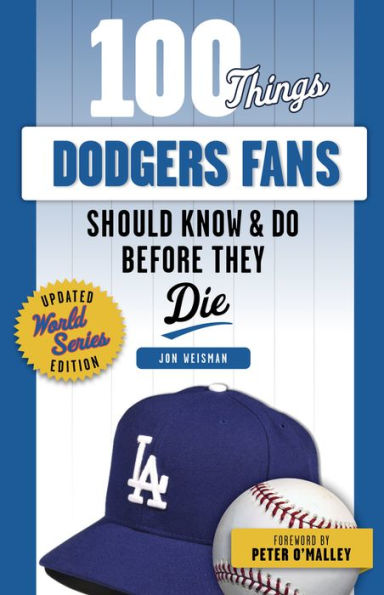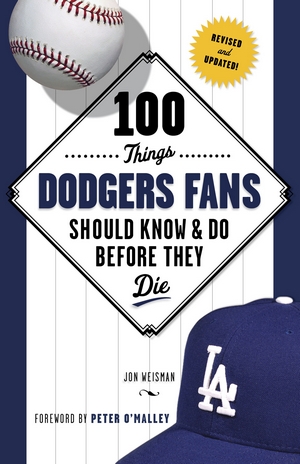Exciting news! For the first time since 2013, a new edition of my book, 100 Things Dodgers Fans Should Know & Do Before They Die, is about to be released. Updated to include events leading up to the Dodgers’ World Series title, the 2021 version officially publishes June 1, and you can preorder now!
Ever since the first edition came out in 2009, I have always aspired for this book to be the ideal resource for any fan of the Dodgers: young or old, casual or passionate, focused on the present or the past. And now, I can finally say the book has caught up to the most eventful decade of the past half-century in the history of the franchise.
Coming in at a record 368 pages, this new third edition captures all kinds of highlights from the past eight Dodger seasons — the many highs and the devastating lows — culminating in the wonderful catharsis of the 2020 World Series. The new 100 Things Dodgers also offers new chapters and sidebars focused on the more recent Dodger stars and personalities, including Cody Bellinger, Mookie Betts, Andre Ethier, Andrew Friedman, Kenley Jansen, Yasiel Puig, Dave Roberts, Hyun-Jin Ryu, Corey Seager, Justin Turner and Juan Uribe. I have also updated previous material on Jaime Jarrín, Eric Karros, Matt Kemp and much more, including Dodger Stadium itself. And needless to say, after 2020, Clayton Kershaw stands out as someone whose body of work called out for a new look.
Here’s a snippet, from the opening of my new introduction to the third edition, to set the stage:
Officially, Triumph Books published the second edition of 100 Things Dodgers Fans Should Know & Do Before They Die the morning of April 1, 2013.
You might say that a lot has happened in Dodger history since then.
In fact, only hours after the previous edition hit the public, Clayton Kershaw took a George Kontos fastball over the center-field wall at Dodger Stadium, breaking a scoreless tie on his way to pitching a shutout against the Giants in the first game of the season. That Opening Day was the opening salvo in an unprecedented run of Dodger history: eight straight National League West titles, including three NL pennants, leading up to the 2020 season that brought—say it with me now—the Dodgers’ first World Series title in 32 years.
I could write an entire book about those eight seasons alone (and hey, maybe I should). At the same time, that octet of excellence deserves a spot not separate from, but rather in context with, the history of a franchise whose roots date back to the 19th century.
And that’s where this new edition of 100 Things Dodgers comes in. …
While the new edition of 100 Things Dodgers officially hits the stands on June 1, but you can preorder now from such places as …
If you’ve already enjoyed previous editions of 100 Things Dodgers, I feel confident you’ll be happy to step up to this one. And if you haven’t owned a copy of the book yet, this is the perfect time to buy one, for yourself or your friends and family (especially if you need a belated Mother’s Day gift or an elated Father’s Day present).
Let me close out my pitch by returning to the book’s introduction.
… Having this much exciting material to convey is the kind of problem an author dreams of having. As I said in the introduction to the first edition, “The Dodgers aren’t the only epic story around, but they’re a pretty great one—with fantastic characters, emotions, and plot twists that are nearly impossible to abandon.” I wrote that when the franchise had won exactly one playoff series since 1988. To think what has happened since: The Dodgers are truly the gift that keeps on Dodgering.
Whether you are updating your previous edition of 100 Things Dodgers or opening these pages as a newcomer, I hope you’ll find one constant. You might know who Jackie Robinson and Vin Scully are, what 1951 and 1955 represent, how “Dodgers” itself is a unique name in sports. My mission remains to tell the story behind the story, to inform as well as reminisce, to enlighten and enliven, no matter how casual or diehard a fan you are. The years since 2013 have only made that mission more dear. No matter what brings you to this book, I hope you find memories big and small from throughout the history of the Dodgers to treasure.
And with that, I hope you buy 100 Things Dodgers Fans Should Know & Do Before They Die today!





